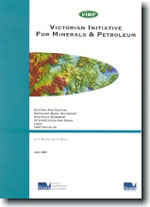VIMP Report 69 - Eastern and central Gippsland Basin, southeast Australia; basement interpretation and basin links
 |
| |||||||||||||||
Product description:Download The downloadable version of this report is supplied in PDF format. Abstract This report describes the Gippsland Basin basement and its effects on the development of the overlying sequences. The interpretation process has integrated magnetic, gravity, bathymetric, seismic, drilling and onshore mapping data to produce a holistic model. A major change along the axis of the Gippsland Basin divides the western, ‘onshore’ region, the Zone, from the eastern, ‘offshore’ region, the and zones. The Selwyn Block, the northern extension of western Tasmania, is present below the Zone; it seems to have generally been more stable than the Lachlan Fold Belt basement typical of eastern Victoria. In the area examined in detail, the Zone has a total basin section typically less than 2 km thick, mostly dominated by the upper part of the Strzelecki Group. Thin caps on hilltops of Upper Cretaceous and Cainozoic sedimentary and volcanic rocks suggest that the Zone has not been massively eroded. The region has generally been seen to be oil and gas poor. By contrast the Zone sedimentary section is up to 15 km thick and has a greater range of sediment types and thicker units. The Zone is also extremely fertile for oil and gas production. Most of the known major oil and gas accumulations cluster around the edge of a large east-west trending magnetic low, which parallels the convex-south arcuate thrust faulting present in the onshore Lachlan Fold Belt rocks. The oil-prone area is close to the deepest part of the Zone. The Kingfish-Tuna Transition Zone crosses the Zone from northeast to southwest. This previously recognised structural divide seems to have a basement expression at its southern end and perhaps in the north too. In the Central Deep there is only subtle evidence of its presence in the basement. The Transition Zone seems to mark a change in polarity of the graben system into which the lower Strzelecki Group was deposited. This implies that there is a change in top-basement dips across the Transition Zone. From east of the Blackback and Basker discoveries, rocks with different magnetic signatures underlie the Gippsland Basin. These comprise the Zone. Projected south, in the Cretaceous the Sydney-Gunnedah-Bowen Basin system would have passed about 50 km east of the Gippsland Basin. The magnetic patterns associated with these Permo-Triassic rocks are similar to those of the Zone, and we propose that similar Permo-Triassic rocks are present beneath the Gippsland Basin in the Zone. The Tullaberga Trough is a newly recognised north-south half-graben system on the eastern edge of the region. This seems to contain a thicker section of the Permo-Triassic rocks. Although it includes the Sole discovery, the Zone is largely unexplored as it is mostly in deep water. It includes the Southeastern Strzelecki Graben System, where, particularly in the north, there is a thick section of the Golden Beach Subgroup and Cobia and Halibut subgroups. Dredging by the Geoscience Australia in the eastern Bass Canyon and further south shows that it contains Santonian lignitic clays, the same age as the Golden Beach Subgroup. Bathymetric and seismic data shows that up to about 2 km of Santonian sedimentary rocks are present. At least some of the rocks may be part of the Tasman Basin, separated from the Gippsland Basin by the Gippsland Rise. About 30 subcircular crater-like structures, interpreted to be vents, are present in the floor of the Bass Canyon at about 4 km water depth. Many seem to be positioned along faults that cut rocks of the Golden Beach Subgroup and the Cobia and Halibut subgroups. If the vents were emitting hydrocarbons, it would imply that hydrocarbon migration is presently taking place in the Zone and the Tasman Basin. The oldest faults affecting the Gippsland Basin seem to be reactivated Palaeozoic north-south basement faults and the generally east-west trending Foster and Lake Wellington fault systems. Each of the major basin-bounding faults is interpreted to have been cut by younger faults. In the basement many of the major faults can be resolved into several short straight segments and are more complex than have conventionally been drawn on published maps. The Tuna and Marlin channels drain into the Bass Canyon, suggesting that the Canyon may have existed in some form in the Eocene. A faulting episode probably took place at about 22 Ma, essentially coeval with the Thorpdale Volcanics. The resulting uplift may also have caused the channeling at the mid-Miocene marker. It seems possible that the hydraulic instability associated with this event further eroded the weakly consolidated and faulted Palaeogene and Upper Cretaceous sediments, forming the Bass Canyon in essentially its present shape. Bibliographic reference Moore, D.H. & Wong, D, 2002. Eastern and Central Gippsland Basin, Southeast Australia; Basement Interpretation and Basin Links. Victorian Initiative for Minerals and Petroleum Report 69. Department of Natural Resources and Environment. Related products:
| ||||||||||||||||


